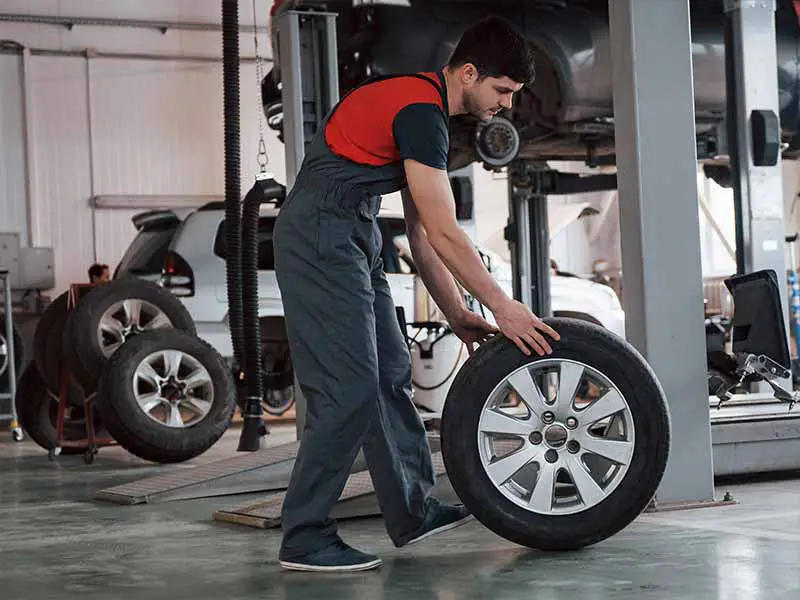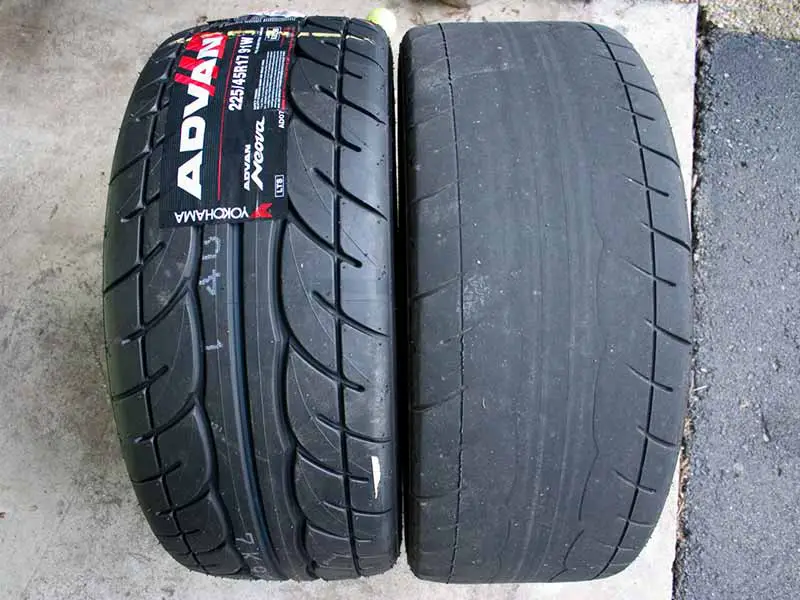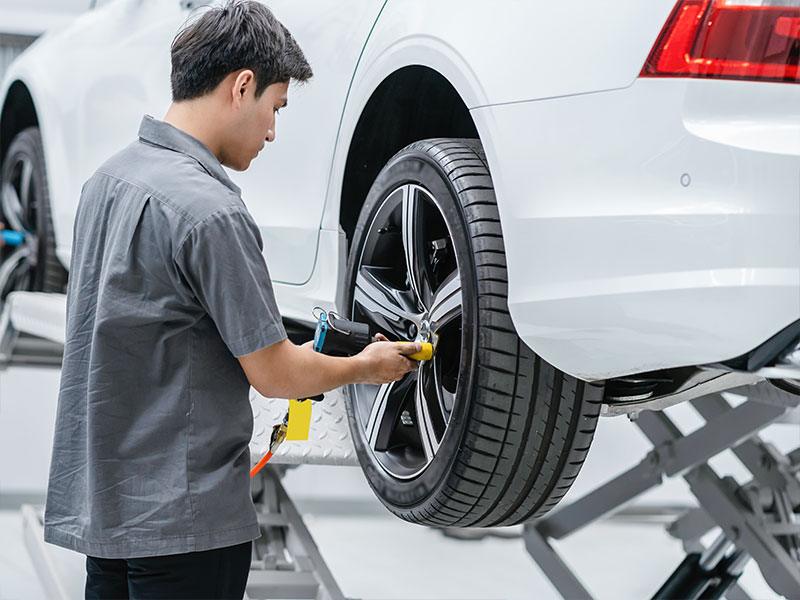Tire rotation is the process of moving each of the tires on your vehicle to different positions for a period of time. This is repeated on a regular schedule, usually every 5,000-8,000 miles.
The purposes for this tire maintenance service are to extend tire life, create more even tire wear, reduce road noise and vibrations, increase safety, and comply with the requirements to maintain your tire warranty.
When tires wear down, each tire on a car or truck will do so differently. This may be due to whether the vehicle is front-wheel-drive or rear-wheel-drive for example. Suspension geometry will also affect how tire tread will wear down.

If you do not rotate your tires, the tread can wear down more in one area, such as the outer shoulder, until it loses all of the treads in that location and the tire will need to be replaced. This is despite having significant tread left on the middle and inner shoulder of the tire.
Not only is regularly rotating your tires at the tire manufacturers’ rotation schedule is meant to extend the life of your tires and is required to prevent voiding the tire manufacturer’s mileage warranty.
What Is Tire Rotation
Tire rotation is a tire maintenance process of moving each of the tires on your vehicle to different positions for a period of time. This is repeated on a regular schedule.
The purposes for tire rotation are to extend tire life, reduce road noise, increase tire safety, and comply with the requirements to maintain your tire warranty.
Tire Rotation Meaning
Tire rotation means moving a tire from one position on your car or truck to another. For instance, moving a front passenger side tire to the rear passenger side location.
Tire Rotation Direction Vs Tire Rotation Pattern
When tires are rotated on a car they are usually rotated in a pattern that is determined by the way the vehicle is propelled forward. For instance, the rotation pattern of a front-wheel-drive car will be different than that of an all-wheel-drive car.
Tire Rotation Pattern
A tire rotation pattern is the set of positions that a given tire should move to for that pattern. The wording sounds confusing but the concept is fairly simple.
For instance, front-wheel-drive cars commonly use a rotation pattern called the X-Pattern. To rotate tires in the X-Pattern, swap the driver’s side front tire with the passenger side rear tire. Next swap the passenger side front tire with the driver’s side rear tire.
Tire Rotation Direction
Tire Rotation Direction is a completely different concept. Many tires are designed to only rotate in one direction. Meaning that when they roll on the road, the tread pattern is designed to grip the road when the tire is rotating in one direction and not the other. Mounting a directional tire backward will cause it to perform very poorly and void the tire manufacturer’s warranty.
Some tires do not have a specific required rotational direction and can be mounted on either side of a vehicle with either tire sidewall facing outward. Directional tires have markings indicating how the tire should rotate while rolling.DIRECTIONAL TIRE EXAMPLE
Directional tires will have an indication on the sidewall to show which way the tire should rotate. The wording may vary but there should be an arrow of some type associated with the wording.
Is Tire Rotation Necessary?
Tire rotation is necessary to maintain your tire manufacturer’s warranty. Proof of your tires being rotated according to the tire manufacturer’s specification is required to claim the tire warranty if you have a problem with your tires.
It is not strictly necessary otherwise, but skipping tire rotation will reduce the usable lifespan of your tire tread.
The reason you should rotate your tires is to ensure that your tire tread wears down evenly and to make the tires last longer. For example, front-wheel-drive cars will experience accelerated tire wire on the front tires compared to the rear. Rotating the rear tires to the front will balance the wear and allow the tire set to last longer.
It’s best to have common services performed together. Rotating your tires, wheel alignment, and oil changes are good examples.
Tire manufacturers usually cut the tire warranty by 50% on vehicles that can’t have their tires rotated normally.
TireGrades Expert Tip
When Not To Rotate Tires
There are 2 situations where rotating your tires can’t or shouldn’t be done:
Staggered AND Directional Tires
Some cars, usually higher-performance cars, will have what is called staggered wheels. What this means is that the wheels at the front of the car are narrower than the wheels at the back of the car. Staggered tires can only be rotated side-to-side. If the tires on a staggered car are also directional you should not rotate your tires at all. If you were to rotate the tires side-to-side the tread will be facing the wrong direction and the tires will not be able to grip properly.
Excessive Tire Wear
If you have two excessively worn tires that are near or needing replacement and two tires that are in good condition or better, the good tires should be on the rear. If this is already the case, you should not rotate your tires. While excessively worn tires should be replaced, it is safer to have those tires on the front.
The reason is that if one end (front or rear) of your car is going to lose traction, it’s safer to have the front end lose traction than the rear.
A loss of traction of the front wheels is called “understeer” and a loss of traction by the rear wheels is called “oversteer”.
If you are in this situation, however, you should strongly consider replacing the excessively worn tires as soon as possible. Tires are at their best when brand new and gradually lose performance as they wear. When tires are near, at, or past the wear bars, their performance is dramatically reduced. It’s obviously dangerous to drive on tires that are at or past the wear bars.
These are the same make and model of tire. The tire on the left is new. The tire on the right has completely failed at only 9,000 miles of use.
EXCESSIVE TIRE WEAR EXAMPLE
These are the same make and model of tire. The tire on the left is new. The tire on the right has completely failed at only 9,000 miles of use.

What Is The Proper Tire Rotation Pattern?
Tire rotation patterns are mostly determined by the drive wheels. The wheels that drive a vehicle forward will be subjected to the most force and wear the fastest. The best way to rotate your tires will largely depend on which wheels are driving your car or truck forward.
The other factors that affect how you can rotate unique situations:
- Dually Truck
- Staggered Wheels
- Directional Tire Tread
We have broken down all of the possible tire rotation patterns by the factors that limit the best patterns for tire rotation:
Front-Wheel Drive (FWD) Tire Rotation Patterns
Forward Cross
In a Forward Cross Pattern, the front tires are simply moved to the rear of the same side of the vehicle. The rear tires are moved to the front but on opposite sides of the vehicle.
X-Pattern
In an X-Pattern tire rotation, the driver’s side front tire should always be swapped with the passenger side rear. The passenger side front tire should always be swapped with the driver’s side rear tire.
Rear Wheel Drive (RWD) Tire Rotation Patterns
Rearward Cross
In a Rearward Cross Pattern, the rear tires are simply moved to the front of the same side of the vehicle. The front tires are moved to the rear but on opposite sides of the vehicle.
X-Pattern
In an X-Pattern tire rotation, the driver’s side front tire should always be swapped with the passenger side rear. The passenger side front tire should always be swapped with the driver’s side rear tire.
All-Wheel Drive & Four By Four (AWD & 4×4) Tire Rotation Patterns
Rearward Cross
In a Rearward Cross Pattern, the rear tires are simply moved to the front of the same side of the vehicle. The front tires are moved to the rear but on opposite sides of the vehicle.
X-Pattern
In an X-Pattern tire rotation, the driver’s side front tire should always be swapped with the passenger side rear. The passenger side front tire should always be swapped with the driver’s side rear tire.
Directional Tire Rotation Patterns
Front To Rear
Directional tires can only be rotated by moving the front tire to the rear of the same side and the rear to the front of the same side. Directional tires can not be moved to the other side of the vehicle because the tire would spin in the wrong direction than the tread was designed to work.
How Do You Know If A Tire Is Directional?
Directional tires will have an indication of the rotational direction on the sidewall. This is usually an arrow with the word “Direction” or “Rotation” next to it.
Asymmetrical Tire Rotation Patterns
Asymmetrical tires are similar to directional tires but have the advantage of being able to be rotated like a symmetrical tire while not being limited to a symmetrical tire pattern. For this reason, there isn’t a specific tire rotation pattern for an asymmetrical tire, and the rotation pattern will depend on other factors.
How Do You Know If A Tire Is Asymmetrical?
Asymmetrical tires will have an indication printed on the sidewall to let the installer know which sidewall should be facing outward and which sidewall should be facing inward. This is typically just the word “Outside” on the outer sidewall and “Inside” on the inner sidewall.
Staggered Tire Rotation Pattern
Staggered tires mean the tires in the front are narrower than the tires in the rear of the vehicle. This is common in high-performance and rear-wheel drive vehicles. It is intended to help prevent oversteer and increase traction.
Due to the wheels on the front axle being narrower than those on the rear axle, vehicles with staggered wheelsets can only be rotated side-to-side.
5-Tire Rotation Patterns
The 5-tire rotation pattern is recommended when you have a full-size spare tire that is mounted on a wheel that is identical to the other four wheels on your car or truck and the tire is not a “Temporary Use” tire.
The idea is to get the spare tire into the rotation circulation pattern and help extend the life of the entire set of tires. Unfortunately most passenger cars these days don’t have a spare tire at all, let alone a full-sized spare.
Where 5-tire rotation comes into play is with larger vehicles, such as trucks and SUVs, that can easily store a full-sized spare. For instance, Jeeps often have a full-sized spare mounted on the rear tailgate.
5-Tire Forward Cross (FWD)
In the 5-Tire Foward Cross, the passenger rear tire is moved to the driver’s front. The driver’s front is moved to the driver’s rear. The driver’s rear is moved to the passenger front. The passenger front is moved to the spare tire location. And finally, the spare tire is put into use as the passenger side rear.
5-Tire Rearward Cross (RWD & AWD/4×4)
In the 5-Tire Rearward Cross, the passenger rear tire is moved to the passenger front. The passenger front is moved to the driver’s rear. The driver’s rear is moved to the driver’s front. The driver’s front is moved to the spare tire location. And finally, the spare tire is put into use as the passenger side rear.
Dually Tire Rotation Pattern
Due to the unique layout of having four tires in the rear, duallies have their own rotation pattern. On a dually, the front tire rotates to the outside rear of the same side. The outside rear rotates to the inside rear of the same side. The inside rear rotates to the front of the same side. When rotating tires on a dually you don’t need to rotate tires from side to side of the vehicle.
There are other rotation patterns that can be done for duallies to help deal with irregular wear but this is the primary rotation pattern.
Resources
Below are some links you may find helpful when learning about tires





